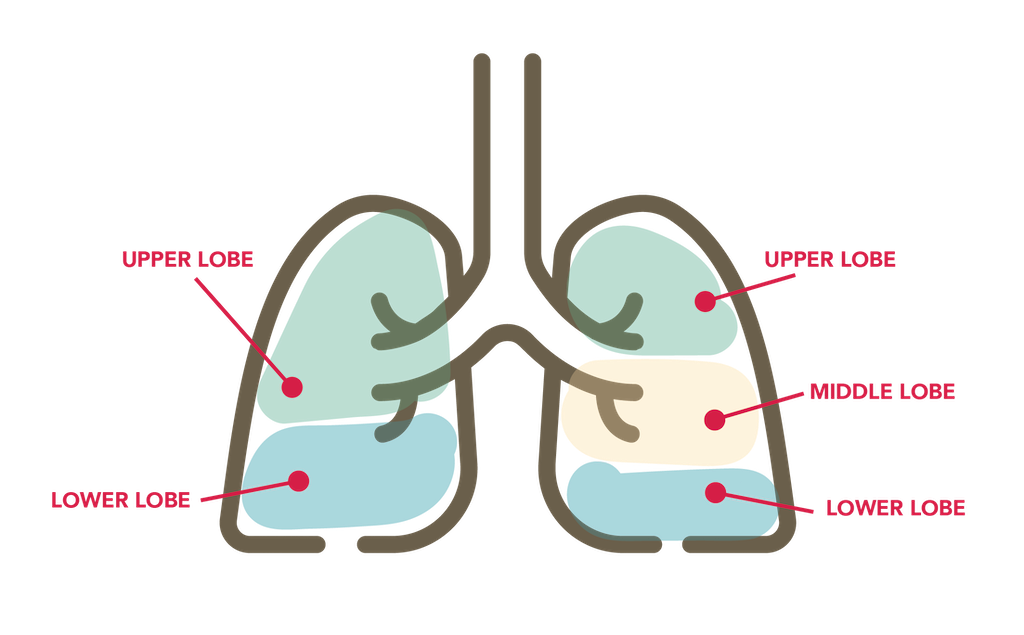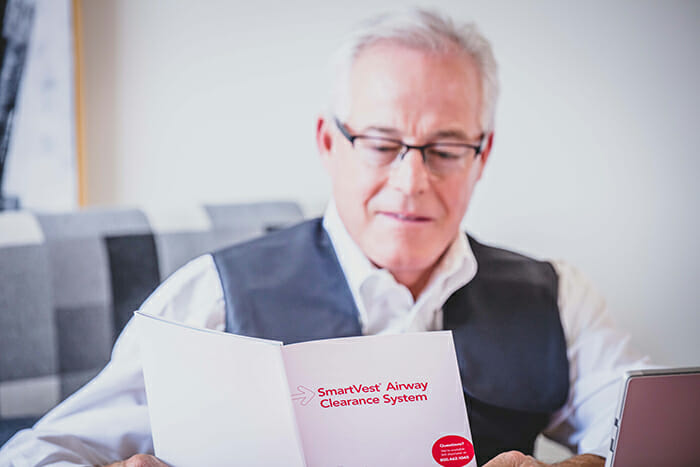
Manual Chest Physiotherapy (or chest physical therapy) requires the assistance of a caregiver or respiratory therapist to perform repeated clapping on a patient’s chest wall, also known as percussion.
The goal of chest physical therapy (CPT) is to help dislodge mucus in the lungs and then apply postural drainage techniques¹ to allow mucus to drain from different areas of the lungs to the mouth, where patients can cough it up.
Why Is Chest Physical Therapy Important?
CPT is one of many airway clearance techniques that support patients living with chronic lung diseases, like cystic fibrosis or bronchiectasis. Because both conditions can cause patients to produce thick, sticky mucus, it becomes more difficult to break up phlegm and move up and out of the lungs.
When mucus stays in the lungs, it can lead to inflammation and a respiratory infection, both of which can cause symptoms to worsen over time and permanently damage the lungs and airways.
Chest physiotherapy techniques, such as percussion and postural drainage, may help patients loosen and expel mucus, preventing the onset of mucus buildup.
Now that we understand how CPT works, let’s quickly review how it’s performed at home.
Performing Chest Physical Therapy at Home
Before we begin, it’s important to note that you can perform manual CPT independently; however, this will only allow you to target the upper lobes of your lungs.²

You have two lungs, and each one is divided into lobes. Your left lung—which is smaller than your right—only has two lobes (an upper and lower lobe). Your right lung has three lobes (an upper, middle, and lower lobe). The lobes receive air from its own branch of your bronchi (i.e., airways).³
However, when you perform CPT manually, you won’t be able to target your lower lobes, which means you won’t be able to receive 360° chest coverage.
Therefore, manual CPT is typically performed by a caregiver or respiratory therapist. The reason for this is it requires multiple claps in different areas of the lungs. You may also need to lie in various positions to target each lobe to help loosen mucus more effectively.
Manual Clapping and Vibrations
By cupping the hand to help soften the clapping movement, a caregiver will begin clapping your chest wall repeatedly. The caregiver will clap using a steady, even beat. Once the caregiver completes a series of percussions, she will use a steady hand to create a shaking motion to create vibrations within the lungs.4
After manual percussion, postural drainage typically follows. This technique utilizes gravity to move the mucus toward the mouth so the patient may cough it up.
Manual CPT cannot be performed by just anyone, as it requires an understanding of your lung anatomy and how to target different lobe areas. Additionally, your caregiver will need to know when to have you switch positions to allow proper drainage and perform steady even beats (claps) on your chest wall for an extended time to allow the breakup of mucus.
Though Manual CPT can effectively clear mucus buildup, a more practical option is available.
Performing Airway Clearance Therapy Independently
High-Frequency Chest Wall Oscillation (HFCWO) therapy uses the same techniques as manual CPT (i.e., percussion and vibration to loosen mucus). However, rather than relying on another individual to help you perform therapy, you operate a respiratory vest independently.
The SmartVest Airway Clearance System offers HFCWO therapy in a convenient and comfortable garment worn around the chest wall that is connected by a single hose to a generator. Once activated, the machine sends air to the inflatable vest that are consistent in frequency and delivery.
SmartVest works to deliver repeated pulses of air and oscillation to help loosen and propel mucus upward, where it’s more easily coughed up. With SmartVest, you have the option of programming your device to provide the same treatment every day. You are also able to adjust therapy to your needs, ensuring you feel comfortable and have more breathing room.™ 5
Our Patient Services team of respiratory therapists are just a phone call (1.888.966.2525) away to help you adjust your settings to fit your needs.
The bottom line:
- SmartVest delivers a consistent treatment every time. With manual CPT, it can differ from day-to-day, depending on who is performing it and the different positions you are in.
- With SmartVest, your prescribed therapy can be pre-programmed and adjusted to suit your comfort level, so you enjoy consistent performance—anytime, anywhere.
- No need to switch positions to experience oscillations or ask for assistance to receive therapy.
With SmartVest, you can expect 360° chest wall coverage, more breathing roomTM, and the ability to perform therapy independently on your schedule.

Is SmartVest Right for You?
Request an informational packet today to learn more about how SmartVest can help you achieve 360° chest coverage! You’ll find clinical resources, testimonials, and more resources on how SmartVest works.
We’ll also include a prescription form for your clinician to complete. This way you can get started in breathing easier and living better.
Finally, when SmartVest arrives at your home, one of our respiratory therapists will schedule a convenient time to set up your device so you feel comfortable performing therapy at home and on your own!
Talk to one of our Respiratory Therapists today at 1.855.528.5690 to discuss symptoms and if SmartVest is the right option for you.
Ready to get started? Discuss SmartVest with your doctor or schedule a time to speak with one of our Respiratory Therapists to answer any questions you may have before your next appointment.
Resources
[1] Cystic Fibrosis Foundation. ” Chest Physical Therapy.” Retrieved from https://www.cff.org/managing-cf/chest-physical-therapy
[2] Cystic Fibrosis Foundation. ” Chest Physical Therapy.” Retrieved from https://www.cff.org/managing-cf/chest-physical-therapy
[3] American Lung Association. “How Your Lungs Get the Job Done.” Retrieved from https://www.lung.org/blog/how-your-lungs-work
[4] Cystic Fibrosis Foundation. ” Chest Physical Therapy.” Retrieved from https://www.cff.org/managing-cf/chest-physical-therapy
[5] Pokorney J. Comparison of Oscillatory Trough Pressure Generated by High Frequency Chest Wall Oscillation (HFCWO) Systems: A White Paper.


